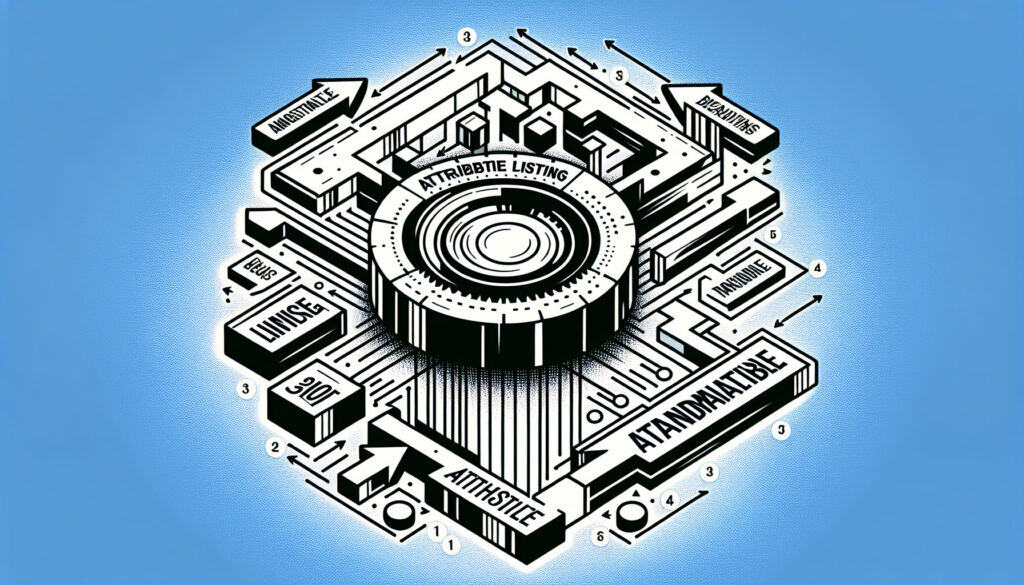Technique de remue-méninges qui consiste à décomposer un problème ou un objet en ses éléments ou attributs constitutifs.
- Méthodologies : Clients et marketing, Économie
Liste des attributs

Liste des attributs
- Remue-méninges, Créativité, Pensée conceptuelle, Idéation, Innovation, Techniques de résolution de problèmes, Amélioration des processus, Gestion de la qualité, Ingénierie de la valeur (EV)
Objectif :
Comment il est utilisé :
- En dressant la liste des attributs d'un problème ou d'un objet, vous pouvez ensuite réfléchir à des moyens d'améliorer chaque attribut. Cela peut déboucher sur de nouvelles idées et solutions.
Avantages
- Il s'agit d'une technique simple et facile à utiliser, qui permet de générer un grand nombre d'idées et qui peut être appliquée à un large éventail de problèmes.
Inconvénients
- Elle peut prendre du temps, ne pas être adaptée à tous les types de problèmes et la qualité des idées dépend de la créativité des participants.
Catégories :
- Idéation, Résolution de problèmes
Idéal pour :
- Générer de nouvelles idées en analysant systématiquement les caractéristiques d'un problème ou d'un objet.
La liste d'attributs peut être particulièrement efficace dans des secteurs tels que l'électronique grand public, la conception automobile et l'industrie automobile. dispositif médical Les produits doivent répondre à des normes de performance et de sécurité spécifiques tout en répondant aux souhaits des consommateurs. Au cours de la phase d'idéation d'un projet, les équipes de conception peuvent utiliser cette méthodologie en recueillant les contributions transversales des ingénieurs, des spécialistes du marketing et de l'expérience utilisateur afin de créer une liste complète d'attributs qui caractérisent le produit. Cette approche encourage la collaboration, car les membres de l'équipe peuvent identifier des attributs qui n'auraient pas été pris en compte par d'autres, tels que la facilité d'utilisation, le coût et l'impact sur l'environnement. Par exemple, lors du développement d'un nouveau smartphone, des attributs tels que l'autonomie de la batterie, la taille de l'écran, le poids et le matériau peuvent être analysés et améliorés, ce qui favorise l'apparition de caractéristiques innovantes telles que des technologies à faible consommation d'énergie ou de nouveaux facteurs de forme. Cette technique est souvent mise en œuvre par les chefs de produit ou les concepteurs principaux, mais elle bénéficie de la participation de diverses parties prenantes, notamment des utilisateurs finaux, qui peuvent fournir des informations précieuses sur leurs besoins et leurs préférences. La flexibilité de la liste d'attributs permet de l'appliquer dans différents contextes, y compris lors de séances de brainstorming en amont ou de phases ultérieures de perfectionnement du produit, ce qui en fait un outil polyvalent permettant de générer une multitude de solutions créatives qui améliorent la qualité du produit et la satisfaction de l'utilisateur. Dans des contextes tels que les sprints de conception ou les ateliers, les équipes peuvent rapidement converger vers des attributs prioritaires pour une exploration plus approfondie, établissant ainsi une voie claire pour les phases ultérieures du cycle de développement du produit.
Principales étapes de cette méthodologie
- Identifier l'objet ou le problème analysé.
- Dressez la liste de tous les attributs ou caractéristiques associés à l'objet ou au problème.
- Analyser chaque attribut pour déterminer les domaines à améliorer.
- Faites un remue-méninges pour trouver des idées et des solutions pour améliorer chaque attribut.
- Évaluer la faisabilité et l'impact des idées générées.
- Classez les idées par ordre de priorité en fonction des avantages potentiels et des difficultés de mise en œuvre.
Conseils de pro
- Encouragez les membres de l'équipe à adopter des perspectives cognitives différentes au cours du processus d'inscription, afin d'améliorer la créativité grâce à la diversité des points de vue.
- Utiliser des outils numériques ou des logiciels pour l'établissement de listes d'attributs, permettant une organisation, une visualisation et une collaboration efficaces entre les équipes.
- Revoir et mettre à jour régulièrement la liste des attributs au fur et à mesure de l'émergence de nouvelles idées ou tendances du marché, afin de garantir la pertinence des efforts de réflexion.
Lire et comparer plusieurs méthodologies, nous recommandons le
> Référentiel méthodologique étendu <
ainsi que plus de 400 autres méthodologies.
Vos commentaires sur cette méthodologie ou des informations supplémentaires sont les bienvenus sur le site web de la Commission européenne. section des commentaires ci-dessous ↓ , ainsi que toute idée ou lien en rapport avec l'ingénierie.
Contexte historique
1949
1950
1950
1960
1960
1960
1960
1940
1950
1950
1958
1960
1960
1960
1960
(si la date est inconnue ou n'est pas pertinente, par exemple "mécanique des fluides", une estimation arrondie de son émergence notable est fournie)















Articles Similaires
Calculateur de METS en calories
Méta-analyse
Cartographie des messages
Diagrammes du modèle mental
Forces de poussée et de traction maximales acceptables
Planification des besoins en matériaux (MRP)